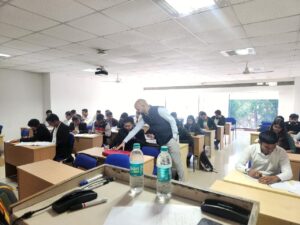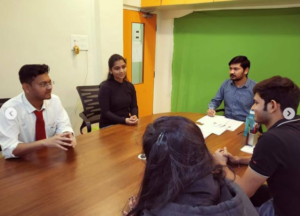Resume Building, Written Ability Test, Group Discussions/Exercises and Personal Interviews
(GD-PI-WAT)

Resume Building refers to the process of creating a document that showcases your professional background, skills, education, and accomplishments to potential employers. The purpose of a resume is to provide a concise and targeted Summary of your Qualifications, aiming to convince recruiters or hiring managers that you are a suitable candidate for a specific job position.
When building a resume, you typically include sections such as Personal Information, Objective Or Summary Statement, Work Experience, Education, Skills, Accomplishments, Projects, and any relevant Volunteer Work. The goal is to present your credentials in a clear and organized manner, tailored to the requirements of the job you are applying for.
By highlighting your strengths, relevant experiences, and achievements, a well-crafted resume can significantly increase your chances of getting noticed by employers and securing job interviews. Remember to Customize Your Resume for Each Application, focusing on the Skills and Experiences that are most Relevant to the Position you Seek.

Written ability tests are assessments used to evaluate a candidate’s Writing Skills and Communication Abilities. These tests are commonly employed during the hiring process, especially for roles that require Strong Written Communication.
In a written ability test, candidates are given a Specific Topic, Prompt, or Scenario and are asked to write an Essay, Report, or Response within a given Time Frame. The test aims to assess various aspects of the candidate’s writing, including Grammar, Vocabulary, Coherence, Logical Reasoning, Creativity, and Overall Effectiveness of Communication.
The content and format of the written ability test can vary depending on the employer and the nature of the job. Some tests may be conducted online, while others may be administered in person as part of an interview process. The assessment helps employers gauge a candidate’s written communication skills, which are crucial for roles where effective writing is a key aspect of the job.
This has been included as a part of the Selection Process at Most of the Top B-Schools after clearing MBA Entrance Exams like CAT, SNAP, MBA CET, XAT, NMAT, IIFT, TISSNET, CMAT, MICAT, XGMAT, MAT, ATMA etc. and BBA Entrance Exams like IPMAT, SET, NMIMS NPAT, DUET (DU JAT), IPM Aptitude Test, CUET, BMCC, MIT WPU, Jai Hind Entrance etc.

Group discussions are Structured Interactions involving a small group of individuals who gather to discuss a particular Topic, Issue, or Problem. They are commonly used in various settings, such as educational institutions, job interviews, business meetings, and community forums. The main objective of a group discussion is to Facilitate the Exchange of Ideas, Opinions, and Perspectives among the participants.
During a group discussion, participants are usually given a specific Topic or Case Study to discuss. They are expected to express their viewpoints, analyze the topic critically, and engage in constructive debate with one another. Group discussions are often moderated by a facilitator or a leader who ensures that the conversation remains focused and respectful.
Key aspects of group discussions include:
Communication Skills: Participants need to effectively express their thoughts and actively listen to others.
Collaboration: The group members must work together to explore the topic from various angles and reach conclusions.
Leadership: Some participants may naturally emerge as leaders, guiding the discussion and encouraging participation from all members.
Problem-Solving: Group discussions often involve solving issues collectively by exploring different solutions.
Time Management: Participants need to utilize the allocated time efficiently to cover the topic thoroughly.
Group discussions provide an opportunity to assess an individual’s ability to communicate, collaborate, think critically, and work effectively within a team, making them a common component of selection processes for job interviews, admission to educational institutions, and team-building activities.
This has been included as a part of the Selection Process at Most of the Top B-Schools after clearing MBA Entrance Exams like CAT, SNAP, MBA CET, XAT, NMAT, IIFT, TISSNET, CMAT, MICAT, XGMAT, MAT, ATMA etc. and BBA Entrance Exams like IPMAT, SET, NMIMS NPAT, DUET (DU JAT), IPM Aptitude Test, CUET, BMCC, MIT WPU, Jai Hind Entrance etc.

Group exercises, also known as Group Activities or Group Tasks, are Collaborative Activities in which a Group of individuals Work Together to Solve a Problem, Complete a Task, or Achieve a Common Objective. These exercises are often used in various settings, such as team-building workshops, assessment centres, training programs, and educational settings.
The purpose of group exercises is to assess and develop various skills and qualities, including Teamwork, Communication, Leadership, Problem-Solving, Decision-Making, And Time Management. Participants are typically given a specific Challenge or Scenario and are expected to collaborate, brainstorm ideas, and collectively reach a solution.
Examples of group exercises include:
Team Challenges: Participants must work together to overcome obstacles or complete physical tasks that require cooperation and coordination.
Case Studies: Groups analyze and discuss a given scenario or business case, offering solutions or recommendations.
Role-Playing: Participants act out specific roles in a simulated situation, emphasizing communication and problem-solving skills.
Debates: Groups engage in structured discussions with opposing viewpoints, promoting critical thinking and persuasion.
Creative Projects: Groups work on creative endeavours, such as designing a product, creating a marketing campaign, or planning an event.
Group exercises are valuable in assessing how individuals interact and contribute within a team dynamic. They provide valuable insights into a candidate’s ability to Collaborate, Adapt to Different Group Dynamics, and Contribute Constructively to Achieving Collective Goals. Additionally, group exercises offer participants an opportunity to learn from each other, build relationships, and enhance their interpersonal skills.
This has been included as a part of the Selection Process at Most of the Top B-Schools after clearing MBA Entrance Exams like CAT, SNAP, MBA CET, XAT, NMAT, IIFT, TISSNET, CMAT, MICAT, XGMAT, MAT, ATMA etc. and BBA Entrance Exams like IPMAT, SET, NMIMS NPAT, DUET (DU JAT), IPM Aptitude Test, CUET, BMCC, MIT WPU, Jai Hind Entrance etc.

Personal interviews, also known as Face-To-Face Interviews, are one-on-one interactions between an Interviewer and an Interviewee. They are a common method of gathering information and evaluating candidates in various contexts, such as job hiring, research, admissions processes, and media interviews.
In a personal interview, the interviewer asks questions related to the topic or purpose of the interview, and the interviewee responds with their answers and insights. The questions can be Open-Ended or Structured, designed to assess the interviewee’s Knowledge, Skills, Experiences, Personality, and Suitability for a particular role or situation.
Key aspects of personal interviews include:
Interaction: The interview is conducted in a direct and personal setting, allowing for real-time exchange of information and responses.
Probing: Interviewers may delve deeper into specific answers or ask follow-up questions to gain a better understanding of the interviewee’s perspectives.
Nonverbal Cues: Both verbal and nonverbal communication play a role in the interview, including body language and facial expressions.
Rapport: Establishing a positive rapport with the interviewee can encourage them to share more openly and honestly.
Evaluation: Personal interviews help assess the interviewee’s qualifications, competencies, and overall fit for a job, research study, or other purposes.
Personal interviews offer a more in-depth and nuanced understanding of the interviewee compared to other assessment methods. They provide an opportunity for interviewers to gauge the candidate’s suitability beyond what can be seen on a resume or through written responses. However, they may also be influenced by interviewer biases and require skilled interviewers to conduct them effectively and fairly.
This has been included as a part of the Selection Process at Most of the Top B-Schools after clearing MBA Entrance Exams like CAT, SNAP, MBA CET, XAT, NMAT, IIFT, TISSNET, CMAT, MICAT, XGMAT, MAT, ATMA etc. and BBA Entrance Exams like IPMAT, SET, NMIMS NPAT, DUET (DU JAT), IPM Aptitude Test, CUET, BMCC, MIT WPU, Jai Hind Entrance etc.
The ‘Interviews Preparation’ Program with KATEC will be taken by Tier-1 (Top 20) MBA College Alumni with a minimum of 3-4 Years of Corporate Experience. This will be available Online as well as In-Person. Under this, we will Scrutinize your Resume, Do a Mock Interview covering Question Types such as CV-Based Questions, Subject Knowledge Questions, HR Questions, and Current Affairs Questions and will also Test students’ Communication Skills and Body Language during the same. Post this we will Provide Feedback and Areas of Improvement regarding the above Parameters and Evaluate and Provide you A Score. If you Score Well in Any of the Interviews with Us, you will Receive a Certificate for the same.
